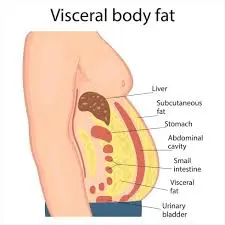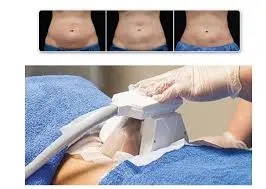Fat Freezing (Cryolipolysis)
Introduction
Fat freezing, or cryolipolysis, is a non-invasive cosmetic procedure that uses controlled cooling to freeze and eliminate stubborn fat cells. The treated fat cells gradually break down and are naturally removed by the body over time. It is commonly used for body contouring in areas like the abdomen, thighs, and love handles, with results appearing over several weeks.
Pain and discomfort are among the mild side effects of CoolSculpting. Additionally, a rare side effect that some people may encounter is the growth of fat cells rather than their shrinkage.
A branded version of cryolipolysis, a non-invasive medical technique that helps get rid of extra fat cells beneath your skin, is called CoolSculpting.
Although CoolSculpting offers several advantages, if you’re thinking about getting the surgery, it’s vital to understand the dangers. CoolSculpting is approved as a safe medical procedure by the FDA in the United States.
Compared to liposuction and other fat-reduction techniques, CoolSculpting offers numerous advantages. There is no recuperation period and it is non-invasive and non-surgical.
It may take four to six months for damaged fat cells to leave the body after surgery. On average, cryolipolysis decreases fat in the treated area by 20%.
Cryolipolysis, also known as fat freezing, is a nonsurgical fat reduction procedure that uses cold temperatures to reduce fat deposits in specific body parts. It is not meant for obese individuals and is intended to reduce localized fat deposits or bulges that do not respond to diet and exercise. The method is known as CoolSculpting and is patented.
Which body parts are best suited for cryolipolysis?
The Food and Drug Administration has approved cryolipolysis to treat fat deposits according to the chin and upper arms, both inner and outer thighs, abdominal region, hip/flank, upper back, lower back, and beneath the buttocks.
Procedure Specifics
Patients often refer to cryolipolysis as “CoolSculpting” since it breaks down fat cells using a chilly temperature. Unlike other cell types, fat cells are more vulnerable to the effects of cold. The skin and other components remain unharmed as the fat cells freeze.
Over 450,000 procedures have been carried out globally, making it one of the most widely used nonsurgical fat reduction methods.
An applicator with the right size and curvature is selected following an evaluation of the fatty bulge’s dimensions and shape. To determine the location of the applicator, the area of concern is marked. The skin is shielded by a gel pad. After applying the applicator, the bulge is suctioned into the applicator’s hollow. The area becomes numb as the applicator’s internal temperature decreases. The vacuum’s pull on the tissue can occasionally cause discomfort for patients, but this goes away in a matter of minutes after the area is numb.
During the process, patients usually read, watch TV, or use their smartphones. The suction is turned off, the applicator is taken out, and the region is massaged after the one-hour treatment, which could enhance the outcome.
Either an outpatient facility or a doctor’s office may do the treatment. A skin-marking pencil is used to delineate the region to be treated once the size and shape of the fatty deposit have been evaluated. Throughout the surgery, patients remain conscious.
The adipocyte layer, which is the layer of fat cells beneath the skin, is frozen using a portable tool known as an applicator. To protect the skin, a gel pad is first put on the affected area. The fatty bulge is then vacuumed or suctioned into the hollow hole of the applicator. As suction is administered, you will experience a pulling or tugging feeling.
The area becomes numb during the cooling process, so these sensations—intense cold plus other potential sensations like tingling, stinging, hurting, and cramping—go away after five to ten minutes. The goal temperature of 30.2 to 39.2 degrees Fahrenheit is progressively reached by cooling the fat layer.
A region can take up to an hour to treat. The applicator is taken out once the area has been treated. To help break down the fat cells, the area can be rubbed for two to three minutes.
Macrophages, a type of white blood cell and a component of the body’s immune system are called to the site of the injury to remove the dead fat cells and debris from the body. This technique is based on the discovery that fat cells are more vulnerable to damage from cold temperatures than other cells, such as skin cells. The cold temperature damages the fat cells, which causes the body to go into inflammatory mode, which leads to the death of the fat cells.
Who Is It For?
If you’ve tried diet and exercise but still have a fat bulge that won’t go away, CoolSculpting can be a viable alternative. It won’t aid in weight loss because it simply targets little areas of fat. However, it’s an excellent option if you want to “contour” or smooth out a certain area of your body.
Cryolipolysis can be used by a physician to eliminate fat cells in regions such as:
- Beneath the jawline and chin
- Belly Thighs
- Sides and back
- Below the butt
- Along the line of the bra
- The upper arm
The fundamentals of body fat
The body contains two different kinds of fat: visceral and subcutaneous.
The majority of your body fat is subcutaneous fat. It is the kind that surrounds your arms, legs, and waist and is found as a layer beneath the skin.
Although subcutaneous fat is a necessary component of the human body, having too much of it might raise your chance of developing serious illnesses including type 2 diabetes and heart disease.
Subcutaneous fat is the target of cryolipolysis techniques.
Visceral fat

The stomach, intestines, and liver are among the primary organs that are encircled by visceral fat. It may accumulate in the arteries as well.
Although visceral fat is necessary for the proper functioning of your vital organs, excessive visceral fat can lead to insulin resistance, hypertension, and serious health issues.
The dangers and adverse consequences of CoolSculpting
Even though CoolSculpting is usually safe, there could be some negative effects after the procedure.
The following are some typical CoolSculpting side effects:
- Aching or pain
- You can feel some pain, stinging, or aching at the treatment site after a CoolSculpting procedure. This can be because the treatment uses extremely frigid temperatures.
In 2015, a study examined the outcomes of 554 cryo-lipolysis operations performed over one year. According to the review, any post-treatment soreness often subsided on its own after three to eleven days. Your skin may become irritated by Coolsculpting’s exposure to chilly temperatures.
This may result in:
- Skin sensitivity, edema, bruises, and transient discoloration
- These usually go away on their own in a matter of weeks.
- Paradoxical adipose hyperplasia
- Infrequent yet serious, paradoxical adipose hyperplasia is an adverse effect of CoolSculpting. Here, the treatment site’s fat cells enlarge instead of contract.
The precise reason for paradoxical adipose hyperplasia brought on by cryo lipolysis is unknown, however, it is more common in male patients.
Although paradoxical adipose hyperplasia is a cosmetic rather than a medically hazardous side effect, the increased fat cells must be removed by corrective liposuction or another type of surgery.
Find out more about CoolSculpting’s adverse effects here.
Cryolipolysis can be performed at your physician’s office. You shouldn’t need to plan recovery time thereafter because you should be able to resume your normal activities immediately. Driving yourself home from the appointment is acceptable.
You can experience a severe cold, tingling, hurting, and a pulling or tugging sensation on your skin throughout the procedure. As the area numbs, these sensations may disappear in a few minutes.
Following the procedure, you may have adverse effects such as:
- Redness
- Swelling
- Paleness
- Getting bruised
- Firmness
- Stinging and tingling
- Tenderness or aching
- The cramps
- Itching
- Sensitive skin
- The sensation of fullness in the back of your throat (if your chin was used for the surgery)
- Feeling numb
Infrequently, you may receive:
- Paradoxical hyperplasia
- Inflammation throughout the body
- Fat cells entering the bloodstream is known as a fat embolism.
- Lipoma (a mass of fat)
- Excruciating or postponed agony
- Freeze burn
- Lightheadedness or fainting
- skin thickening in depth
- Excessive pigmentation
- A hernia
- After a while, your skin may appear less smooth. This is because the surrounding areas continue to protrude even after the treatment eliminates a tiny pocket of fat. Additional CoolSculpting procedures or liposuction can correct this.
Who is a suitable CoolSculpting candidate?
CoolSculpting aids in the localized fat tissue removal process. It’s a fat loss treatment, not a weight loss one.
Therefore, anyone who wants to minimize or eliminate localized areas of fatty tissue that continue to exist after diet and exercise is a good candidate for CoolSculpting and other cryo-lipolysis procedures.
Treatments involving cryolipolysis are less successful in obese and high-fat individuals.
According to a study of the research, persons in good health who have no history of skeletal or neurological issues and normal kidney function are the best candidates for cryolipolysis procedures like CoolSculpting.
Who ought to stay away from CoolSculpting?
For most people, CoolSculpting is a safe and efficient way to lose body fat. However, some people shouldn’t be treated this way. CoolSculpting is not recommended for those with the following conditions:
- Cold agglutinin sickness and cryoglobulinemia
- Cold hemoglobinuria with paroxysmal episodes
- For those with certain conditions, CoolSculpting may result in serious consequences.
It’s crucial to see your physician before choosing a plastic or cosmetic surgeon to carry out the treatment, regardless of whether you already have any of these conditions.
It’s also critical to remember that CoolSculpting is not an obesity treatment. Instead, it can aid in the removal of tiny quantities of extra fat that are difficult to lose with diet and exercise alone.
Losing weight is not possible with cryolipolysis. Consult your physician about altering your diet and exercise regimen if you need to reduce weight. CoolSculpting is probably not as beneficial as liposuction or weight reduction surgery if you need to shed a lot of weight.
Additionally, you should refrain from using cryo-lipolysis if you have:
- Loose skin
- Unhealthy skin tone
- A disorder known as cryoglobulinemia causes your blood’s aberrant proteins to thicken in cold weather.
- A skin disorder called cold urticaria develops hives when it gets cold.
- When exposed to cold temperatures, a kind of anemia known as paroxysmal cold hemoglobinuria causes your red blood cells to be destroyed.
- Chilblains, pernio, or Raynaud’s phenomenon (diseases that impair blood flow at cold temperatures)
- An infection
- A hernia
Also, you should stay away from it if you:
- Unable to tolerate cold
- Are you nursing or pregnant?
- Obese
Areas that should not undergo cryo-lipolysis include:
- Varicose veins
- Nerve issues
- Lesions or rashes
- Many scars
- inadequate blood flow
- Ask your doctor about options such as liposuction, exercise, diet, or abdominoplasty (tummy tuck) if you fit into any of these categories.
What drawbacks does cryolipolysis have?
The following are some drawbacks of cryolipolysis:
Only those who are in good general health, free of neurologic or orthopedic issues, and who want to “spot” reduce body fat in particular regions are advised to have the operation. It is not advised for obese individuals to undergo cryolipolysis.
After healing, there’s a chance that the skin’s surface will be uneven or rough.
To get the desired benefits, a person could require multiple sessions.
The next session cannot be held until six to eight weeks following the first if many therapy sessions are required. This is because the body’s removal of damaged fat cells might take this long.
The results are not immediately apparent. It may take three to six months to get the best outcomes because fat cells are eliminated from the body gradually.
The occurrence of paradoxical adipose hyperplasia is one uncommon adverse effect. After cryolipolysis, fat cells in this uncommon disorder enlarge. The likelihood of experiencing it is higher for men and Hispanic individuals.
It is possible to gain weight following cry lipolysis. There are additional parts of the body where fat can accumulate.
Does anyone have a contraindication to cry lipolysis?
- Obese individuals should not undergo cry lipolysis. Additionally, it shouldn’t be done on skin that has been cut or wounded, has dermatitis, significant varicose veins, or other skin diseases.
- Candidates with abnormal cold sensitivity or cold intolerance should not apply. Those with the following conditions are not advised to have the procedure:
- The phenomena of Raynaud. An uncommon disorder where blood flow to the fingers and toes can be impeded by cold conditions.
- Cryoglobulinemia. is a form of vasculitis, or blood vessel inflammation, brought on by aberrant proteins that solidify or gel when exposed to cold temperatures. Along with other issues, it is linked to blocked blood vessels.
- Paroxysmal cold hemoglobinuria. A relatively rare autoimmune illness in which red blood cells are destroyed during exposure to cold.
- Chilly urticaria. A rare disorder where exposure to cold causes the skin to break out in red, itchy patches called hives.
- Illness caused by cold agglutinin. In this uncommon form of autoimmune hemolytic anemia, the body’s immune system unintentionally targets and kills its red blood cells. Cold weather frequently causes the ailment or exacerbates it.
Additional risky circumstances include
- Being pregnant or nursing
- Nerve conditions, including diabetic neuropathy
- Skin conditions that cause inflammation
- Skin illnesses like psoriasis and eczema that are brought on by immune system problems
The rate of satisfaction is high and the rate of complications is minimal. Asymmetry and surface imperfections are possible. Patients might not receive the desired outcome. Rarely, paradoxical fat hyperplasia—an unanticipated rise in the number of fat cells—may occur in less than 1% of patients. Men are three times more likely than women to experience this, and people of Hispanic or Latino heritage are more likely to do so.
Cryolipolysis has several benefits, including the following:
No surgical incision is necessary; it is a low-risk procedure; there is no risk of infection; it can be done as an outpatient procedure; patients are not required to be sedated or anesthetized before the procedure; multiple body parts may be treated in a single session; most patients can return to their regular daily activities right away following treatment; it can be done on patients of all ages; damaged or destroyed fat cells are permanently removed from the body; and it causes no long-term harm to the skin in the treatment area.
Because of the improvement in their appearance, patients may feel more confident.
When can I expect to see benefits from cryolipolysis and how much-localized fat can I expect to lose?
According to studies, four months after starting treatment, there is an average fat decrease of 15–28 percent. However, as soon as three weeks following therapy, you can start to observe changes. After roughly two months, there is a noticeable improvement.
What adverse consequences may one anticipate right after cryolipolysis?
The following are possible short-term adverse effects for the treated areas:
- Aches or pain
- Skin irritation or tingling
- Redness
- Swelling
- Bruising or discoloration of the skin
- Numbness or sensitivity of the skin
- After treatment, side effects could last anywhere from a few days to a few weeks. To ease pain or other discomfort, your doctor can advise you to take an analgesic drug.
What is the average number of cryolipolysis treatment sessions required?
You may have a single problematic area that needs treatment, multiple problematic areas that need treatment, or multiple areas that require treatment to reach your desired outcome. You and your doctor will work together to create a plan that will best meet your goals, including the number of treatment sessions.
CoolSculpting: Is it safe?
Coolsculpting and other cryolipolysis techniques have received FDA certification as safe for usage. According to several assessments, cryolipolysis is a dependable, risk-free substitute for liposuction operations with little adverse effects.
However, little is known about the medicines’ long-term consequences because they are relatively new to the market.
Expectations Following CoolSculpting
You should be able to resume your normal activities practically soon following your CoolSculpting procedure. Remember to make a follow-up appointment.
Bruising, swelling, numbness, and redness are likely to be side effects. Usually, these go away in a week as well as two. However, CoolSculpting might cause numbness in some people that lasts for weeks.
Likely, you won’t see effects immediately. This is because your body needs time to eliminate the damaged fat cells. The CoolSculpting website states that full effects should be seen by 12 weeks, with results beginning to appear after roughly 6 weeks.
According to other studies, it takes around three to six months following therapy to get full outcomes. According to some research, the procedure may also aid in skin tightening.
It’s crucial to maintain healthy behaviors after the treatment. After CoolSculpting, weight gain is still possible. Any weight increase will likely be dispersed equally across your body. Consult your physician to determine the best diet and exercise regimen for you.
How to accelerate the benefits of CoolSculpting
Research on how to expedite CoolSculpting outcomes is nonexistent. However, research is being done on how providers can help you have better results. For instance, right after treatment, the physician can give the area a massage.
Additional research is examining if the quantity of CoolSculpting sessions, the application of heat, and combination therapy with electromagnetic radiation or deoxycholic acid could enhance outcomes. However, before providers begin implementing these tactics, more research might be required.
Cost of CoolSculpting
One treatment that is seen as cosmetic is cryolipolysis. Consequently, insurance will not pay for it.
The cost of cryolipolysis is determined by several factors:
- Your desired body part (smaller parts cost less)
- How many sessions do you have?
- Who does your procedure?
- Where you are
- For instance, cryolipolysis for the arms might only require one session per arm and be less expensive per session than for larger areas like the hips or stomach. A customized treatment plan usually costs between $2,000 and $4,000, according to the CoolSculpting website.
Alternatives to CoolSculpting
Other methods for fat removal, reduction, or breakdown include:
- One kind of plastic surgery that eliminates fat deposits is liposuction.
- Laser-based heat treatments (SculpSure) that eliminate fat
- Kybella, an injection of deoxycholic acid that breaks down fat cells, is only utilized on the chin.
- A radiofrequency technique that uses heat to eliminate fat cells (TruSculpt, Vanquish)
- A cold laser procedure that reduces fat cells (Zerona)
- Emsculpt is an electromagnetic treatment that tightens muscles and breaks down fat cells.
- Consult your physician before undergoing any cosmetic surgery.
Conclusion
CoolSculpting offers certain advantages over other fat-elimination techniques if you’re a good candidate.
There is no scarring following treatment, and it is a non-invasive process. Additionally, no rest or recuperation period is necessary. After their last treatment, most patients see full improvements within six months, however, results may start to appear in a few weeks.
If you’ve tried diet and exercise but are still unable to remove a persistent fat bulge, CoolSculpting can be a viable alternative. A device will be used by the provider to freeze and kill fat cells in a specific area of your body.
It is generally regarded as safe, doesn’t require anesthetic, and may be performed in a doctor’s office. However, it can have certain negative effects and won’t aid in weight loss. To find out if CoolSculpting is correct for you, consult your physician.
FAQs
Does cryolipolysis via fat freezing work?
Research indicates that depending on the area being treated, up to 28% of the fat may go four months later. Even though cryolipolysis has FDA approval and is seen to be a safe substitute for surgery, negative effects are possible. “Paradoxical adipose hyperplasia,” or PAH, is one of these.
For whom is cryolipolysis not a viable option?
Cryolipolysis should not be performed on patients who have cold-related disorders such as paroxysmal cold hemoglobulinuria, cold urticarias, or cryoglobulinemia. The technique might not be appropriate for patients with loose skin or low skin tone.
What is the duration of cryolipolysis fat freezing?
The benefits of the CoolSculpting procedure are permanent, which is its best feature. The fat cells are permanently lost once they are destroyed.
How much does it cost to freeze fat with cryolipolysis?
Cryolipolysis fat-freezing treatments typically cost between INR 15,000 and INR 80,000 each session. The following are the primary determinants of cost: Size of the treatment area: Generally speaking, larger areas like the thighs or belly cost more. Number of sessions: For best outcomes, several sessions can be needed.
What adverse consequences might cryolipolysis cause?
Bruising, edema, numbness/paresthesia, and treatment-site erythema were the most frequent adverse events linked to cryolipolysis. Serious side effects of cryolipolysis include paradoxical adipose hyperplasia, motor neuropathy, skin hyperpigmentation, severe/persistent pain, and dysesthesia.
Can fat return following cryo-lipolysis?
A certain amount of permanency is ensured in the treated area by the freezing of fat cells, which are permanently removed once removed. The lifetime of the outcomes is therefore maintained as long as a person continues to eat a healthy, balanced diet.
What is the purpose of cryolipolysis?
The reduction of fat volume in a fatty bulge is the aim of cryolipolysis. Some patients may choose to retract an area more than once or have multiple areas treated.
Reference
- Professional, C. C. M. (2025a, January 24). Fat freezing (Cryolipolysis). Cleveland Clinic. https://my.clevelandclinic.org/health/treatments/21060-fat-freezing-cryolipolysis
- American Society of Plastic Surgeons. (n.d.). Cryolipolysis | Nonsurgical fat reduction. https://www.plasticsurgery.org/cosmetic-procedures/nonsurgical-fat-reduction/cryolipolysis
- Cirino, E. (2023, April 20). Understanding the risks of CoolSculpting. Healthline. https://www.healthline.com/health/coolsculpting-risks#takeaway
- CoolSculpting for Fat Loss: Is it safe? (2024, September 11). WebMD. https://www.webmd.com/beauty/coolsculpting



